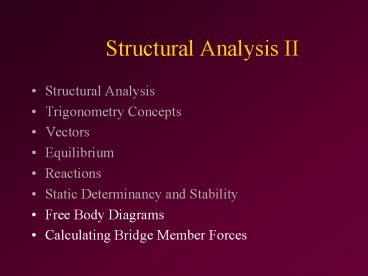Structural Analysis II PowerPoint PPT Presentation
1 / 25
Title: Structural Analysis II
1
Structural Analysis II
- Structural Analysis
- Trigonometry Concepts
- Vectors
- Equilibrium
- Reactions
- Static Determinancy and Stability
- Free Body Diagrams
- Calculating Bridge Member Forces
2
Learning Objectives
- Generate a free body diagram
- Calculate internal member forces using the Method
of Joints
3
Free Body Diagram
- Key to structural analysis
- Draw a simple sketch of the isolated structure,
dimensions, angles and x-y coordinate system - Draw and label all loads on the structure
- Draw and label reactions at each support
4
Structural Analysis Problem
- Calculate the internal member forces on this
nutcracker truss if the finger is pushing down
with a force of eight newtons.
5
Structural Analysis SolutionDraw the Free Body
Diagram
Step 1 Draw simple sketch with dimensions,
angles, and x-y coordinate system
- Nutcracker truss formed by tied ends
Corresponding sketch
6
Structural Analysis SolutionDraw the Free Body
Diagram
Step 2 Draw and label all loads on the structure
- Nutcracker truss
- with 8N load
Added to free body diagram
7
Structural Analysis Solution Draw the Free Body
Diagram
Step 3 Draw and label all reactions at each
support
- The truss is in equilibrium so there must
reactions at the two supports. They are named Ra
and Rb.
8
Structural Analysis Solution Method of Joints
- Use the Method of Joints to calculate the
internal member forces of the truss - Isolate one joint from the truss
- Draw a free body diagram of this joint
- Separate every force and reaction into x and y
components - Solve the equilibrium equations
- Repeat for all joints
9
Structural Analysis Solution Method of Joints
- Step 1 Isolate one joint
- Step 2 Draw the free body diagram
10
Structural Analysis Solution Method of Joints
Step 3 Separate every force and reaction into x
and y components
- First analyse Ra
- x-component 0N
- y-component 4N
11
Structural Analysis Solution Method of Joints
Step 3 Separate every force and reaction into x
and y components
- Next analyse Fab
- x-component Fab
- y-component 0N
12
Structural Analysis Solution Method of Joints
Step 3 Separate every force and reaction into x
and y components
- Lastly, analyse Fac
- x-component Faccos70 N
- y-component Facsin70 N
13
Summary of Force Components, Node a
y
x
Fab
14
Structural Analysis Solution Method of Joints
Step 4 Solve y-axis equilibrium equations
- The bridge is not moving, so SFy 0
- From the table,
- SFy 4N Fac cos70 0
- Fac ( -4N / cos70 ) -4.26N
- Internal Fac has magnitude 4.26N in compression
15
Structural Analysis Solution Method of Joints
Step 4 Solve x-axis equilibrium equations
- The bridge is not moving, so SFx 0
- From the table,
- SFx Fab Fac sin70 0
- Fab - ( -4.26N / sin70 ) 1.45N
- Internal Fab has magnitude 1.45N in tension
16
Structural Analysis Solution Method of Joints
Tabulated Force Solutions
17
Structural Analysis Solution Method of Joints
Step 5 Repeat for other joints Step 1 Isolate
one joint Step 2 Draw the free body diagram
18
Structural Analysis Solution Method of Joints
Step 3 Separate every force and reaction into x
and y components
- First analyse Rc
- y-component is -8N
- x-component is 0N
19
Structural Analysis Solution Method of Joints
Step 3 Separate every force and reaction into x
and y components
- Next analyse Fac
- x-component is (Fac sin20)
- - (-4.26N 0.34)
- 1.46N
- y-component is (Fac cos20)
- - (-4.26N 0.94)
- 4.00N
20
Structural Analysis Solution Method of Joints
Step 3 Separate every force and reaction into x
and y components
- Lastly analyse Fbc
- y-component (Fbc cos20)
- x-component (Fbc sin20)
21
Summary of Force Components, Node c
c
Fac
20o
a
22
Structural Analysis Solution Method of Joints
Step 4 Solve y-axis equilibrium equations
- The bridge is not moving, so SFy 0
- From the table,
- SFy -8.00N 4.00N - Fbc cos20 0
- Fbc -4.26N
- Internal Fbc has magnitude 4.26N in compression
23
Structural Analysis Solution Method of Joints
Step 4 Solve x-axis equilibrium equations
- The bridge is not moving, so SFx 0
- From the table,
- SFx 1.46N Fbc sin20 0
- Fbc -4.26N
- This verifies the SFy 0 equilibrium equation
and also the symmetry property
24
Structural Analysis Solution Method of Joints
Tabulated Force Solutions
25
Acknowledgements
- This presentation is based on Learning Activity
3, Analyze and Evaluate a Truss from the book by
Colonel Stephen J. Ressler, P.E., Ph.D.,
Designing and Building File-Folder Bridges

